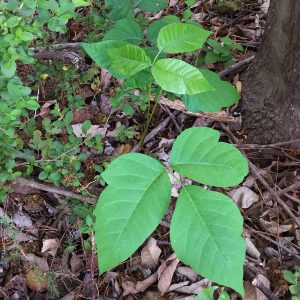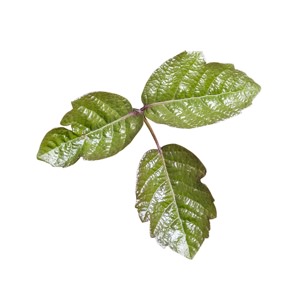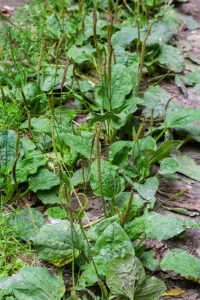
If you are out in the woods or fields this summer, you’ll want to be wary of a noxious weed that can cause a terrible itchy rash. We are referring, of course, to poison ivy. Poison oak and poison sumac also produce the same irritating resin, urushiol.
Prevention is the best medicine. Don’t touch poison ivy or poison oak if you can possibly avoid it. If you do brush up against it, washing as soon as possible with soap and water is essential. Outdoorsmen and women also suggest a couple of healing plants.
Jewel Weed Against Poison Ivy:
Q. You have written about natural remedies and I’d like to share mine. As a field biologist, I learned to crush jewel weed and rub it on any area that had accidentally came in contact with poison ivy. In Missouri, where I live, jewel weed often grows in the same area as poison ivy.
A. Jewel weed (Impatiens capensis) has a reputation for counteracting the irritating resin (urushiol) from poison ivy. Scientists hypothesized that this might be due to saponins (soap-like compounds) in the sap. A study at Ohio Northern University confirmed that crushed jewel weed is effective in reducing poison ivy rash (Journal of Ethnopharmacology, March 13, 2015).
A Reader Relates a Jewel Weed Story:
Q. When researching my master’s thesis for the preservation of a historic road, I hiked the old road with a local man. We walked through a field of shoulder-high plants for about 50 yards when he turned to me and said, “I hope you’re not allergic to poison ivy, cause this is a field of it.”
When I noticed a small spot on one hand starting to itch, the man pulled a weed along a hedgerow where he said it usually grows. He crushed the weed to produce a small amount of liquid and rubbed it on the spot. Within thirty minutes, the spot was completely gone. Any ideas what the plant may be?
A. Many woodsmen and old-timers use jewel weed to treat poison ivy. It is said to work if the juice is applied within 15 minutes or so of exposure. Another plant that has traditionally been used against poison ivy is plantain.
Of course, the best defense is to avoid the three-leaved plant in the first place. If that’s not possible, applying a barrier cream ahead of time can be helpful. IvyBlock, Ivy Shield and Tecnu are designed to keep irritating poison ivy resin away from the skin. Washing with soap and water shortly after exposure can also help prevent a rash. Another product for washing the skin after exposure is Zanfel.
Another Plant to Soothe Poison Ivy Rash:
Q. The best poison ivy remedy I know of is Plantago. I’ve seen people use common plantain leaves rolled up tight until they start to ooze juice. Some people chew the leaves and then wipe the green saliva on the rash.
This works on poison ivy, bee stings, mosquito bites and even diaper rash.
A. Plantain (Plantago major) is a weed that grows in many yards and fields across the country. It has an oval leaf and a central seed spike that children used to shoot at each other.
Herbalists have been recommending the juice of plantain leaves for minor skin irritations for centuries. Some research suggests that an extract of plantain has anti-inflammatory activity along with pain relieving properties (Journal of Ethnopharmacology, Nov. 15, 2022). Studies using laboratory animals as subjects show that it can speed wound healing (Wound Management & Prevention, Jan. 2021).
Extra Poison Ivy Remedies:
Q. My mother-in-law is incredibly sensitive to poison ivy. A walk in the woods is guaranteed to end in disaster. Is there anything she can use that would either prevent an outbreak or speed recovery? The itchy, red blisters drive her crazy!
A. If she can’t avoid poison ivy, the next best thing is to use a barrier cream before exposure. Products such as Ivy Block or Stokoguard can keep the irritating poison ivy oil from penetrating the skin.
After accidental contact, cleansing products such as Tecnu or Zanfel can help. However, simply washing with soap and water also works.
One reader offered the following:
“We were looking at some land with a seller, wading knee deep through poison ivy in shorts. To say that I was scared is an understatement.
“I was persuaded to wash immediately and thoroughly with Dawn dish detergent. Instead of my legs being covered with poison ivy, I only got a few small blisters near one knee, which cleared up quickly. The thing is to wash off as soon as possible.”
Old-timers claim that jewel weed leaves, crushed so the juice runs out, can counter poison ivy if applied near the time of exposure. Others say that witch hazel or vodka, applied directly to the itchy spots, can help speed healing.
If you spend much time in the woods, get someone who knows plants to show you either jewel weed or plantain (preferably both). And definitely learn to identify poison ivy and poison oak so you can avoid them whenever possible. When you can’t, cleaning the area with soap and water, Ivy Wash, Zanfel or alcohol wipes is helpful.
Poison Ivy:

Credit DG
Poison Oak:

Poison Oak leaves isolated with clipping path.
Plantago major:

Plantago major Plantago, Plantain, fleaworts There are 3-5 parallel veins that diverge in wider leaf. The inflorescences on long stalks with short spikes numerous tiny wind-pollinated flowers.
Citations
- Motz VA et al, "Efficacy of the saponin component of Impatiens capensis Meerb.in preventing urushiol-induced contact dermatitis." Journal of Ethnopharmacology, March 13, 2015. DOI: 10.1016/j.jep.2014.12.024
- Farid A et al, "Evaluation of anti-inflammatory effects of leaf and seed extracts of Plantago major on acetic acid-induced ulcerative colitis in rats." Journal of Ethnopharmacology, Nov. 15, 2022. DOI: 10.1016/j.jep.2022.115595
- Cardoso FCI et al, "The effect of Plantago major on wound healing in preclinical studies: A systematic review." Wound Management & Prevention, Jan. 2021.

